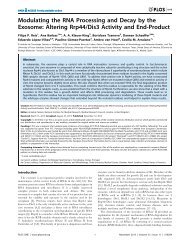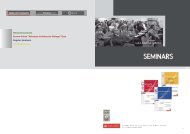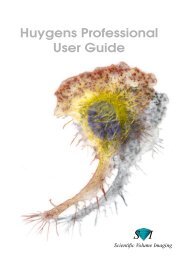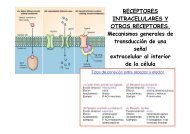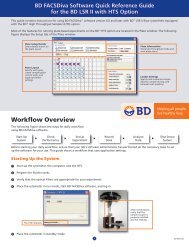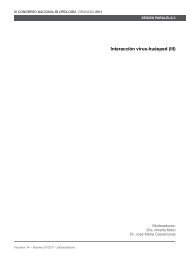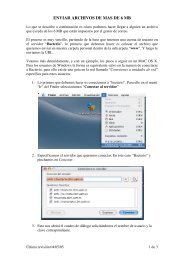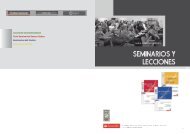Drosophila - Severo Ochoa - Universidad Autónoma de Madrid
Drosophila - Severo Ochoa - Universidad Autónoma de Madrid
Drosophila - Severo Ochoa - Universidad Autónoma de Madrid
Create successful ePaper yourself
Turn your PDF publications into a flip-book with our unique Google optimized e-Paper software.
Jefe <strong>de</strong> Línea /<br />
Group Lea<strong>de</strong>r:<br />
Ricardo Amils<br />
Biología molecular <strong>de</strong> extremófilos<br />
Molecular biology of extremophylic<br />
microorganisms<br />
E3<br />
Personal Científico /<br />
Scientific Staff:<br />
Irma Marín<br />
Francisco Santamaría<br />
José Luis Sanz<br />
Francisco Hernán<strong>de</strong>z<br />
Lola García Grávalos<br />
Postdoctorales /<br />
Postdoctoral:<br />
Moustafá Malki<br />
Emiliano Díaz<br />
Becarios Predoctorales /<br />
Predoctoral Fellows:<br />
Enrique Marín<br />
Antonio García<br />
Lucía Palacios<br />
Nuria Fernán<strong>de</strong>z<br />
Thorsten Köchling<br />
Alberto González Fairen<br />
Nicolás Raho<br />
Lilia Montoya<br />
Monika Oggerin <strong>de</strong> Orube<br />
Carlotta Vizioli<br />
Patxi San Martín-Üriz<br />
Eric Zettler<br />
Técnicos <strong>de</strong> Investigación /<br />
Technical Assistance:<br />
Nuria Rodríguez<br />
Científicos Visitantes /<br />
Visiting Scientists:<br />
Antonio Lazcano<br />
(U. Nacional <strong>de</strong> México, Mexico)<br />
Linda Amaral<br />
(MBL Woods Hole, USA)<br />
Vicente Marcano (<strong>Universidad</strong><br />
<strong>de</strong> los An<strong>de</strong>s, Venezuela)<br />
Sarah Stewart Johnson<br />
(Harvard Medical School, USA)<br />
Konstantinos A. Kormas<br />
(University of Thessaly, Grecia)<br />
Mohieddine Moumni<br />
(<strong>Universidad</strong> Moulay Ismaïl,<br />
Meknès Marruecos)<br />
Rosa Martínez Silvestre<br />
(<strong>Universidad</strong> <strong>de</strong><br />
Cantabria, España)<br />
Beatriz Reguera Ramirez<br />
(Instituto Oceanográfico<br />
Español, Vigo, España)<br />
Regulación <strong>de</strong> la expresión génica Regulation of gene expression<br />
Resumen <strong>de</strong> investigación<br />
El grupo <strong>de</strong> Biología Molecular <strong>de</strong> Extremófilos posee<br />
distintas líneas <strong>de</strong> investigación cuyos objetivos principales<br />
se resumen a continuación:<br />
Acidofilia: ecología molecular, biología molecular y<br />
biotecnología <strong>de</strong> microorganismos que se <strong>de</strong>sarrollan en<br />
ambientes ácidos, con especial énfasis en los aspectos<br />
aplicados <strong>de</strong> los mismos: biohidrometalurgia, bio<strong>de</strong>sulfuración<br />
<strong>de</strong> carbones, secuestro específico <strong>de</strong> metales pesados,<br />
fitorremediación.<br />
Ecología microbiana <strong>de</strong> ambientes extremos terrestres como<br />
mo<strong>de</strong>los <strong>de</strong> interés en astrobiología: geomicrobiología <strong>de</strong> la<br />
cuenca <strong>de</strong>l Tinto (análogo <strong>de</strong> Marte) y <strong>de</strong> las lagunas<br />
hipersalinas <strong>de</strong> la Mancha (análogos <strong>de</strong> Europa). Este trabajo<br />
se <strong>de</strong>sarrolla en colaboración con el laboratorio <strong>de</strong><br />
Extremofilia <strong>de</strong>l Centro <strong>de</strong> Astrobiología (CSIC-INTA).<br />
Ecología molecular microbiana <strong>de</strong> ambientes anaerobios:<br />
I) Caracterización <strong>de</strong> la microbiota <strong>de</strong> sedimentos marinos y<br />
reactores <strong>de</strong>snitrificantes y su implicación, respectivamente,<br />
en la <strong>de</strong>gradación anaerobia <strong>de</strong> alquilbenceno sulfonato<br />
(LAS) y en la eliminación simultánea <strong>de</strong> NO3 - y H2S/S2O3 2-<br />
(<strong>de</strong>snitrificación autotrófica). II) Metanogénesis en ambientes<br />
inusuales. III) Degradación anaerobia <strong>de</strong> xenobióticos<br />
(LAS, organoclorados).<br />
Microalgas tóxicas: I) Desarrollo <strong>de</strong> métodos moleculares<br />
para la <strong>de</strong>tección <strong>de</strong> organismos productores <strong>de</strong> toxinas<br />
diarreicas (DSP) y paralizantes (PSP); II) Aislamiento y<br />
caracterización <strong>de</strong> bacterias asociadas a cepas tóxicas y no<br />
tóxicas <strong>de</strong>l dinoflagelado Alexandrium minutum productor <strong>de</strong><br />
toxinas paralizantes (PSP). Posible interés biotecnológico;<br />
III) Estudio <strong>de</strong> la variabilidad genética <strong>de</strong> Dinophysis spp.<br />
Figura 1.Hibridación <strong>de</strong> fitoplacton marino.<br />
Figure 1. Hybridization of marine phytoplankton.<br />
Research summary<br />
The Extremophiles group has different research projects in<br />
which the main objectives are the following:<br />
Acidophilia: molecular ecology, molecular biology and<br />
biotecnology of microorganisms <strong>de</strong>veloping in acidic<br />
environments, with special emphasis in their potential<br />
applications: biohydrometallurgy, coal bio<strong>de</strong>sulfurization,<br />
specific metal sequestering, phytoremediation.<br />
Microbial ecology of terrestrial extreme environments as<br />
mo<strong>de</strong>ls of interest in astrobiology: geomicrobiology of the<br />
Tinto River Basin (Mars analog) and the hypersaline ponds<br />
from la Mancha (Europa analogs). This work is done in<br />
collaboration with the laboratory of Extremophiles of the<br />
Centro <strong>de</strong> Astrobiología (CSIC-INTA).<br />
Microbial molecular ecology of anaerobic environments:<br />
I) Characterization of the microbiota of marine sediments and<br />
<strong>de</strong>nitrifying reactors and its respective implication in the<br />
anaerobic <strong>de</strong>gradation of alkylbencene sulfonate (LAS) and in<br />
the elimination of NO3 - y H2S/S2O3 2- (autotrophic <strong>de</strong>nitrification).<br />
II) Methanogenesis of unusual environments. III) Anaerobic<br />
<strong>de</strong>gradation of xenobionts (LAS, organochlori<strong>de</strong>s).<br />
Harmful algal blooms: I) Development of molecular<br />
methodologies for the <strong>de</strong>tection of microalgae producing<br />
diarrhetic shellfish poisoning (DSP) or paralytic shellfish<br />
poisoning (PSP), II) Isolation and characterization of<br />
bacteria associated to toxic and non-toxic strains of<br />
Alexandrium minutum, a producer of paralytic shellfish<br />
poisoning (PSP); Posible biotechnological interest. III) Study<br />
of the genetic variability of Dinophysis spp.<br />
Publicaciones<br />
Publications<br />
Bruscella, P., Cassagnaud, L., Ratouchniak, J., Brasseur, G., Lojou, E., Amils, R. and Bonnefoy, V. (2005).<br />
Tat-<strong>de</strong>pen<strong>de</strong>nt processing and translocation in Escherichia coli of the HiPIP from the acidophilic<br />
Acidithiobacillus ferrooxidans. Microbiology. 151, 1421-1431.<br />
Briones, C., Manrubia, S.C., Lázaro, E., Lazcano, A. and Amils, R. (2005). Reconstracting evolutionary<br />
relationships from functional data: a consistent classification of organisms based on translation inhibition<br />
response. Molec. Phylogen. Evol., 34, 371-381.<br />
González-Toril, E., Martínez-Frías, J., Gómez Gómez, J., Rull, F., Amils, R. (2005). Iron-meteorite eating<br />
bacteria. Astrobiology. 5, 406-414.<br />
López-Archilla, A.I., González, A.E., Terrón, M.C., Amils, R. (2005). Diversity and ecological relationships<br />
of the fungal populations of an acidic river of Southwestern Spain: the Tinto River. Canadian J. Microbiol.<br />
50, 923-934.<br />
Amils, R. (2005). Extremofilia, interés astrobiológico. Rev. Esp. Física. 19, 24-28.<br />
Fernán<strong>de</strong>z-Remolar, D., Morris, R.V., Gruener, J.E., Amils, R. and Knoll, A.H. (2005). The Rio Tinto Basin,<br />
Spain: Mineralogy, Sedimentary Geobiology, and implications for interpretation of outcrop rocks at<br />
Meridiani Planum, Mars. Eart Planet.Sci.Lett. 240, 149-167.<br />
Amils, R, Gómez-Elvira, J. (2005). Río Tinto: en busca <strong>de</strong> vida marciana. Espacio. 2, 66-70.<br />
Schulze-Makuch, D., Irwin, L.N., Lipps, J.H., Lemote, D., Dohm, J.M.<br />
and Fiaren, A.G. (2005). Scenarios for the evolution of life on Mars.<br />
J. Geophys. Res. Vol 110, E12S23, doi:10.1029/2005JE002430,2005.<br />
Aguilera, A., Amils, R. (2005). Tolerante to cadmium in<br />
Chlamydomonas sp. (Chlorophyta) strains isolated from an extreme<br />
acidic environment, the Tinto River (SW, Spain). Aquatic Toxicology.<br />
75, 316-329.<br />
Fairen, A.G., Dohm, J.M., Uceda, E.R., Rodríguez, A.P., Baker, V.R.,<br />
Fernán<strong>de</strong>z-Remolar, D., Shulze-Makuch, D. and Amils, R. (2005). Prime<br />
candidate sites for astrobiological exploration through the hydrological<br />
history of Mars. Planetary and Space Science. 53, 1355-1375.<br />
Marín, I., Sanz, J.L. and Amils, R. (editores). (2005). Biotecnología y<br />
medioambiente. Editorial Ephemera. ISBN: 84-609-7344-1.<br />
González-Toril, E., Gómez, F., Malki, M. and Amils, R. (2006). Isolation<br />
and study of acidophilic microorganisms. In: Rainey, F., Oren, A.<br />
(eds.). Methods in Microbiology. Elsevier, Oxford, Vol. 35, pp. 463-502.<br />
Palacios, L., Reguera, B., Franco, J. and Marín, I. (2006). Phylogenetic<br />
diversity of bacteria associated with toxic and non-toxic strains of<br />
Alexandrium minutum. African J. Marine Science. 28, 409-414.<br />
Prieto-Ballesteros, O., Kargel, J.S., Fiaren, A.G., Fernán<strong>de</strong>z-Remolar,<br />
D., Dohm, J.M. and Amils, R. (2006). Interglacial clathrate<br />
<strong>de</strong>stabilization on Mars: Posible contributing source of its atmospheric<br />
methane. Geology. 34, 149-152.<br />
Palacios, L., Arahal, D.R., Reguera, B. and Marín, I. (2006). Hoeflea<br />
alexandrii sp. Nov., isolated from the toxic dinoflagellate Alexandrium<br />
minutum AL1V. Int. J. System. Evol. Microbiol. 56, 1991-1995.<br />
Fernán<strong>de</strong>z, N., Gómez, R., Amils, R. and Sanz, J.L. (2006). Microbial<br />
community of autotrophic <strong>de</strong>nitrifying UASB reactors. In IWC2006,<br />
Porto, Portugal, pp. 284-290. ISBN 972-8688-40-7.<br />
Aguilera, A., Manrubia, S.C., Gómez, F., Rodríguez, N. and Amils, R.<br />
(2006). Eukaryotic community distribution and its relationship to water<br />
physicochemical parameters in an extreme acidic environment, Río<br />
Tinto (Southwestern Spain). Appl. Environm. Microbiol. 72, 5325-5330.<br />
Navarro-González, R., Navarro, K.F., <strong>de</strong> la Rosa, J., Iñiguez, E.,<br />
Molina, P., Miranda, L.D., Morales, P., Cienfuegos, E., Coll, P., Raulin,<br />
F., Amils, R. and MacKay, C. (2006). The limitations on organic<br />
<strong>de</strong>tection in Mars-like soils by thermal volatilization-gas<br />
chromatography-MS and their implications for the Viking results.<br />
PNAS, 103, 16089-16094.<br />
Fernán<strong>de</strong>z, M., Gómez, R., Amils, R., Sierra-Alvarez, R., Field, J.A. and<br />
Sanz, J.L. (2006). Microbiological and structural aspects of granular<br />
sludge from autotrophic <strong>de</strong>nitrifying reactors. Water Science and<br />
Technolog. 54, 11-17.<br />
Malki, M., González-Toril, E., Sanz, J.L., Gómez, F., Rodríguez, N. and<br />
Amils, R. (2006). Importance of the iron cycle in biohydrometallurgy.<br />
Hydrometallurgy. 83, 223-228.<br />
Díaz, E.E., Stams, A.J.M., Amils, R. and Sanz, J.L. (2006). Phenotypic<br />
properties and microbial diversity of methanogenic granules from a<br />
full-scale upflow anaerobic sludge bed reactor trating brewery<br />
wastewater. Appl. Environm. Microbiol. 72, 4942-4949.<br />
Aguilera, A., Gómez, F., Lospitao, E. and Amils, R. (2006). A molecular<br />
approach to the characterization of the eukaryotic communities of an<br />
extreme acidic environment: methods for DNA extraction and<br />
<strong>de</strong>naturating gradient gel electrophoresis analysis. Syst. Appl.<br />
Microbiol. 29, 593-605.<br />
Hutchinson, L., Mustard, J., Gendrin, A., Fernán<strong>de</strong>z-Remolar, D. Amils,<br />
R. and Amaral-Zettler, L. (2006). Finding mineralogically interesting<br />
targets for exploration from spatially coarse visible and near IR<br />
spectra. Earth Planet. Sci. Lett. 252, 201-214.<br />
CBM 2005/2006<br />
118<br />
Figura 2. Estructura <strong>de</strong> lodo granular.<br />
Figure 2. Structure of granular sludge.<br />
Schulze-Makuch, D., Dohm, J.M., Fiaren, A.G., Baker, V.R., Fink, W. and Strom, R.G. (2005). Venus, Mars,<br />
and the ices of Mercury and the Moon: astrobiological implications and proponed misión <strong>de</strong>signs.<br />
Astrobiology. 5, 778- 795.<br />
González-Toril, E., García-Moyano, A. and Amils, R. (2005). Phylogeny of prokaryotic microorganisms from<br />
the Tinto River. In: Harrison, S.T.L., Rawlings, D.E., Petersen, J. (eds.), IBS2005. Cape Town University,<br />
Cape Town, pp. 737-749.<br />
Malki, M., González-Toril, E., Sanz, J.L. Gómez, F., Rodríguez, N. and Amils, R. (2005). Importance of the<br />
iron cycle in biohydrometallurgy. In: Harrison, S.T.L., Rawlings, D.E., Petersen, J. (eds.), IBS2005.<br />
Cape Town University, Cape Town, pp. 737- 749.<br />
Tesis doctorales<br />
Doctoral Theses<br />
Alberto González Fiaren. (2006). Datación <strong>de</strong> posibles procesos<br />
biológicos en Marte en función <strong>de</strong> su historia tectónica y <strong>de</strong> la<br />
evolución hidrogeológica y geoquímica <strong>de</strong> los océanos.<br />
119



